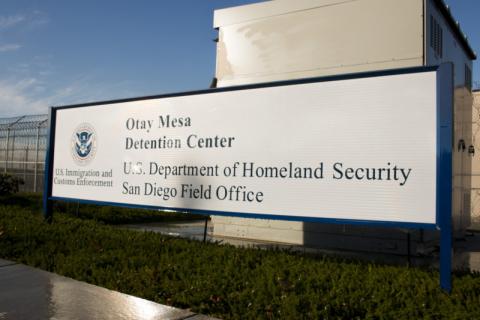<p></p>
<p>Over 33,000 undocumented immigrants remain in the custody of the US Immigration and Customs Enforcement (ICE) after 72 detainees have tested positive for the COVID-19 virus, including one at the Otay Mesa Detention Center in South San Diego.</p>
<p>ICE has recently released 160 low-risk detainees and instructed field offices to review the cases of detainees over 60 years of age and those with certain medical conditions to determine if they can be released to prevent the spread of the virus.</p>
<p>Those in custody also include over 5,800 individuals that have passed government asylum screenings or won their cases but are being detained while the government appeals.</p>
<p>Immigration advocates argue that several thousand detainees could be released to protect them from contracting and spreading the virus.</p>
<p>“Immigrant detainees do not need to be in a detention center in order to be monitored by ICE,” said Immigrant Defenders Law Center’s managing attorney, Margaret Cargioli. “This pandemic can only be adequately managed if everyone is healthy and everyone is in a safe environment.”</p>
<p>The Otay Mesa Detention Center is run by a private contractor, CoreCivic. A CoreCivic spokesperson said they are working to follow the federal guidelines for using masks.</p>
<p>“We’ve been closely following Centers for Disease Control and Prevention recommendations since the beginning of the COVID-19 pandemic,” said Amanda Gilchrist, spokeswoman for CoreCivic. “The CDC’s guidance on the use of masks has recently changed, and we’ve worked hard to quickly ensure that all of our staff and those in our care have access to masks consistent with this new guidance.”</p>
<p>Several detainees in various detention centers around the country have complained that there are not enough masks and personal protective equipment (PPE) for them, and in some cases, even not enough for center staff. Detainees have complained that staff are not wearing gloves and masks when interacting with individuals in the over-crowded detention centers.</p>
<p>Federal and state prisons, as well as local jails, are releasing non-violent inmates in efforts to reduce the risk of spreading the COVID-19 virus.</p>
<p>On March 27th, San Diego County officials began releasing inmates who had 30 days or less left on their sentences after a judge signed a court order. Inmates have been released on parole and home detention to reduce jail populations.</p>
Image
Image

Category